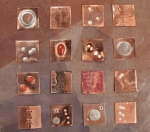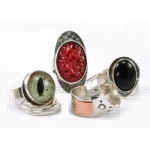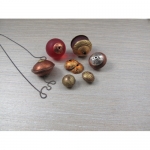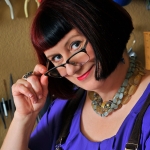2013 Instructor Interview - Kate Richbourg
Discover Soldering with Kate Richbourg
Kate Richbourg's a fun and generous teacher, and she's been designing jewelry for 20 years. Moving from beading to wire work to metalwork and soldering, Kate's eager to demystify the world of metal for you!
Kate sat down for an interview with Heather, our Classes Coordinator, to talk about her metal and soldered jewelry, and what her classes are going to be like in Tucson as well as why you shouldn't be intimidated by soldering and torches. Or, scroll down to read a complete transcript!
(audio not playing? click here)
Don't Miss Kate's Classes this February in Tucson:
 Simple Soldering Sampler Boot Camp 2 Chances to take this class: Feb. 7, full-day  Feb. 8, full-day  |
 Ring Roundup Feb. 9, full-day  |
 Dapped and Capped Beads Feb. 8, full-day  |
Transcript of our interview with Kate Richbourg
Heather: We are on the phone with Kate Richbourg, and she will be teaching with us down in Tucson. Hello Kate!
Kate: Hello Heather! Hello everybody! It's great to chat with you a little bit today.
Heather: Thanks for your time. We'll start with a couple questions. Tell everybody what medium you primarily work in.
Kate: Well I am known for doing metalwork. Metalwork is my favorite, favorite thing to do.
H: Wonderful, was it the first thing you found or was there a process of discovery and experimenting with other mediums first?
Kate: I think like so many people listening, I got into metalworking through the medium of beads. You know beads were kind of like my gateway drug. I started doing beadwork and then I just wanted to start personalizing my pieces and making things uniquely my own. So beads turned into wire-working, and then wire-working finally turned into metalworking, and here I am today. I love working with metal.
Heather: What tools do you use most often and what tools make it possible to do your kind of work?
Kate: You know honestly, I would be lost without a torch. My torch is my number one item that I use, and I use a butane micro torch. So I don't even use a big heavy fancy tank torch or anything like that, it's just micro torch and we're ready to go. Some other tools as well.
Heather: That's essential. Have you ever improvised or repurposed a tool?
Kate: You know, I am always on the hunt for tools. Like everybody, tools are kind of my favorite things. It's one of the things I love about making jewelry.
One of the things that actually pops into my mind is a while back, when I was first starting out, I needed some ear wires for an earrings project, and I didn't have any, or couldn't find them, or something like that. So I actually improvised, using my pair of pliers and a pen to actually create and form that ear wire, so that's actually something that I teach in my class.
Heather: A little jewelry MacGyver there!
Kate: Yes, I actually teach my students how to repurpose a simple pen to use in their jewelry making.
Heather: That's awesome! What is your favorite way to finish a piece or your favorite effect?
Kate: You know, with metal there are so many effects, so I like to make metal super shiny. I like to make it sometimes grungy and antique-looking. There are a lot of great patinas that are out on the market now, so I think the spirit of the piece really tells me, what it is I want to do with the piece. It just depends what the finished piece wants to look like wants to look like, which way I'm going to go with it.
Heather: What advice would you give a beginner who may be a little bit intimidated by how intricate the process seems?
Kate: I know that people have heard it before but I'm going to say it again, we've all started at the beginning.
Even though I've been making jewelry - this is my 20th year as a jewelry designer - I still make mistakes and have to start at the beginning a lot of times for different projects and different processes.
If you are not sure where to jump in, just find a little piece of something, maybe you want to make a cool little pendant or maybe just a string of beads, you know - start with that one bead, and don't worry too much about the outcome. Just take the project step by step, and it'll all work its way out. Start at the beginning and know that we've all started, and we were all beginners, and just go for it.
Heather: Yeah, sometimes some of the greatest things have comes from mistakes, so it can be quite a learning experience.
Kate: Sure! You know there is the saying, if you aren't making mistakes then you aren't learning, and I really agree with that statement for sure.
Heather: Once you make a piece of jewelry that you are happy with, where does it go?
Kate: It usually goes in my class sample box, honestly. I'm always thinking about classes: new classes, new samples, that kind of thing, so it just goes pretty much straight from my workbench to a class sample.
Sometimes I make jewelry as gifts, and sometimes I make jewelry to sell, but most of the time it goes straight from my workbench right into a class sample.
Heather: Cool. What gives you inspiration to try new things? What keeps you motivated?
Kate: Well honestly, I think my students keep me motivated, because I think if people didn't have questions or want to learn new techniques, I would probably just hang out and not do anything new.
But thankfully people ask me questions all the time like, "Kate, how do you do this," or "How do you do that?" and that's what kind of moves me forward, because honestly I would be happy soldering and sawing with my saw, but fortunately I've had to learn several other metalworking techniques because people want to learn them.
Heather: Have you ever rescued a piece that seemed like it was broken? If so how did you do that?
Kate: Nothing really comes to mind immediately. I have though, in the past for sure: when I was a little girl I liked to take broken jewelry and repurpose it. And so I think that's kind of the way I actually started this whole jewelry journey that I'm on. I think that is always really fun and sometimes I still do that.
I look at old jewelry or vintage pieces and try to repurpose and reuse, but mostly those are pieces I keep for myself. Yeah, it's like turning old things into new things for sure.
Heather: Wonderful. Recycling there!
Kate: Yes, a little recycling! Very true!
Heather: Should jewelry artists be intimidated by metal jewelry? And do you have any tips to make metalworking seem more doable?
Kate: I don't think that jewelry artists should be intimidated by anything: whether it's metal or stringing, whatever it is. Because it's all a means to an end, so I say, if you're interested in it, find a class or maybe have a jewelry group or a friend who is really into working with jewelry and pick their brain.
That's the really cool thing I think about our biz, because people are so willing to share their techniques and their ideas. Bead with a buddy! Get some moral support and I think you'll be just fine. We're all in this together, so grab a friend and start creating. I think that will really, really help.
Heather: Perfect. If a jewelry artist wants to get into metal work, what are a few tools or supplies should they have on hand or adding to their work space.
Kate: Well if you're going to start making metal jewelry and soldering, you obviously need a torch and like I mentioned earlier, I use a butane microtorch. And then I just sort of repurposed a few things from around the house: you need a little quenching bowl, you need some good strong light so you can see what you are doing, and then just a few jewelry tools like a soldering pick, and some means to cut your metal, and stuff like that. I think that people are really intimidated because they think it takes so many materials to get started, but it actually doesn't!
To give myself a little plug here, my soldering book just came out in 2012, and it was all about soldering in small spaces. It's actually called "Simple Soldering," so it's pretty cool. You don't need to think about, "Oh my gosh, I need the biggest setup ever!" You actually just need a small setup, just a few key things, and then you're on your way.
Heather: What is the most unusual material you've used to make jewelry?
Kate: I used to have a bead store way back when, and that bead store was in San Francisco, California. So we're kind of free and easy here in our city, I would periodically from time to time have people bring me interesting things to wire wrap so they could wear them around their necks. So, I've actually wire-wrapped a vial of blood.
Heather: Wow!
Kate: it was a little gross! I've wire-wrapped some animal bones, some teeth, all of those weird bodily parts you might not actually want to wear around your neck, but some people actually did, so I just grit my teeth and got my wire and just did it! That might've been too much information for people, but you know what, it's creativity!
Heather: Absolutely! Do you ever use your jewelry-making skills around the house, or to make non-jewelry items?
Kate: What has really helped me actually, I can't think of anything that's super-specific, but it has made me not afraid to use tools. If you can wire-wrap something, you can certainly use a power drill. I can hang my own pictures on the wall and saw my own boards if I need something sawed, so I think it kind of holds over into home maintenance as well.
Heather: Great! I thank you so much for your time and I know that everybody is going to hear your thoughts and knowledge and I really appreciate you sharing that with us. We are very excited to have you down in Tucson.
Kate: I'm really, really, really excited and classes are going to be so fun and I'm so stoked to be teaching with such a great group of instructors and for you guys. So awesome, can't wait to meet everybody!
Heather: Thanks again Kate! Have a good one!
Kate: Thanks Heather.
Don't Miss Kate in Tucson!
 Simple Soldering Sampler Boot Camp 2 Chances to take this class: Feb. 7, full-day  Feb. 8, full-day  |
 Ring Roundup Feb. 9, full-day  |
 Dapped and Capped Beads Feb. 8, full-day  |


 My Cart (Empty)
My Cart (Empty) 


